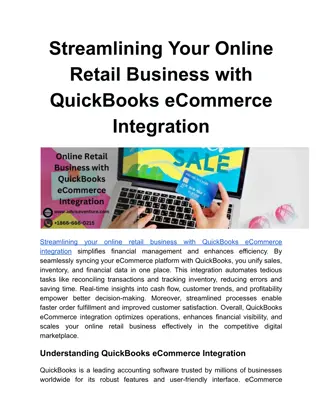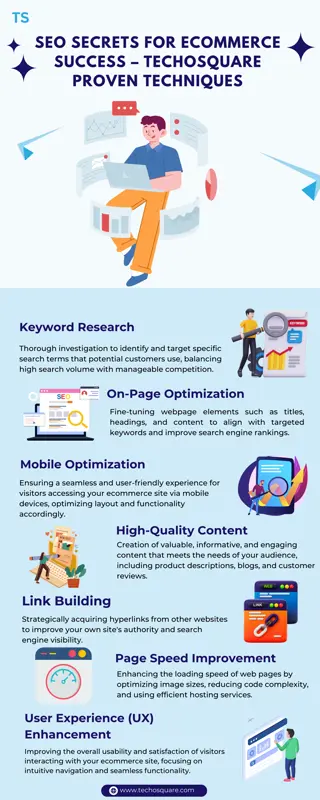
Top 10 B2B eCommerce Trends in 2025 and Beyond
Stay ahead in the competitive B2B eCommerce landscape with this comprehensive guide on the Top 10 B2B eCommerce Trends for 2025 and Beyond. This insightful PDF highlights the game-changing innovations and strategies that are shaping the future of B2B
Download Presentation

Please find below an Image/Link to download the presentation.
The content on the website is provided AS IS for your information and personal use only. It may not be sold, licensed, or shared on other websites without obtaining consent from the author. If you encounter any issues during the download, it is possible that the publisher has removed the file from their server.
You are allowed to download the files provided on this website for personal or commercial use, subject to the condition that they are used lawfully. All files are the property of their respective owners.
The content on the website is provided AS IS for your information and personal use only. It may not be sold, licensed, or shared on other websites without obtaining consent from the author.
E N D
Presentation Transcript
Top 10 B2B eCommerce Trends in 2025 and Beyond As we move toward 2025, B2B eCommerce is going to be the trend. According to a recent market report- The global B2B eCommerce market is valued at USD 21,088.01 billion in 2024 and is expected to hit USD 57,578.97 billion in 2030.
Currently, Amazon, Alibaba, ASOS, Costco Wholesale Corporation, Dangdang, eBay, and Flipkart are some of the major players in the B2B eCommerce market. The following report outlines the overview of the market and main B2B countries, trends, and competitive landscape. So, let's dive into those amazing trends! Top 10 B2B eCommerce Trends that are Shaping 2025 1. Leave Behind Legacy Systems It is crucial to let go of your business from traditional methods these days. They can really hurt your performance and this is more so with today s fast-changing market environment. Of course, old systems may have been good to you, but when the world is moving to a digital era, you need to move to better platforms that are efficient and quick. Modern solutions are better integrated, more flexible, and have features that respond to the expectations of the contemporary buyer. 2. Application of Artificial intelligence (AI)
Lets learn about how artificial intelligence (AI) is proving to be a complete game changer for the B2B e-commerce industry. From implementing an industry s first AI chatbot to solve consumers queries as effectively as a human does to automating product recommendations, writing product descriptions to optimizing pages, the applicability of AI makes teams more productive and customers satisfied. Applications developed using Gen AI, LLM, and NPL are able to create product descriptions, and SEO meta tags within minutes, which can take hours. Yet, what is confusing, there are Generative AI tools on the market with the help of which one can design remarkable landing pages in a few seconds. As such an efficient solution, one can have the flexibility to adjust own positions to trends and meet customer expectations faster. By using the services of an AI software development company, you can integrate AI into your B2B eCommerce solution to gain the chance to deliver personalized services to your customers. 3. Use of eCommerce Platform On this account, the next B2B eCommerce trend for 2025 is to invest in eCommerce platform technology. Well, what you don t know is that the latest platforms such as Shopify, WooCommerce, BigCommerce, etc provide custom pricing, catalogs, and user management. That means such features allow businesses to provide ma ore convenient shopping experience that is relevant especially today when B2B buyers are demanding similar convenience that they get from B2C platforms. 4. Embrace Composability Composability basically being about building your eCommerce platform out of the best services. This is like being able to say I picked out the right parts and if they were magical they would just fit . It makes sense that the development approach helps your eCommerce site not only leverage performance but also proactively factor in future requirements and alterations. The trend is to make your B2B eCommerce software compatible with different types of platforms like payment gateways, checkout APIs, etc.
5. Introduce Personalization to the paradigm of Shopping Online Personalization is the way to go, right? It has been found that it has a major impact on customer satisfaction and therefore a personal selling approach can greatly improve the satisfaction level. Another example of data being used to influence the buyer is by making changes in product suggestions, emails, or even the website design making the buyer feel special. However, today s customers are 80% more likely to make a purchase from a brand, that delivers exceptional value to them. 6. M-Commerce Goes On Developing Well, you carry a smartphone in your pocket, don't you? The latest statistics reveal that the majority of B2B buyers now use their phones to search for products and make their purchases. Mobile is expected to contribute to 54% of the entire mCommerce sales by 2024. Consequently, it is only necessary for businesses to pay attention to the ways the websites they own look and operate on smart, mobile devices, during shopping, mainly. 7. Omni-channel Matters The modern consumer does not want the customer journey to be frayed at any point in the funnel. No matter if the users begin the particular phase on a desktop and finish it on a mobile device or opposite, the most important thing is continuity. Omnichannel strategies have a higher average customer retention rate. Hence, it is well-understood why this B2B eCommerce trend is becoming increasingly popular. 8. Blockchain for Enhanced Security and Transparency Blockchain is so much more than just cryptocurrencies right now. In the world of B2B eCommerce, blockchain technology is being adopted to make supply chains far more secure and transparent. It helps in tracing products while in transit and assists in conducting secure transactions. More and more companies will likely adopt blockchain before 2025 to assure trust and reliability with their partners.
9. Subscription Models on the Rise Subscription models aren't just for Netflix or Spotify. These models provide B2B eCommerce with a predictable revenue stream and long-term customer relationships. In a report by McKinsey, 15% of online shoppers have signed up for at least one subscription to regularly receive products. B2B organizations are catching onto this as a means of improving customer loyalty. 10. Sell Through Third-Party Online Marketplaces Is it not practical to increase your exposure? Third-party online marketplaces expose products to a larger audience; because these websites already keep customer bases, this can provide more sales and increased brand awareness. 11. Fulfill Orders Even Faster This means that speedier delivery is more crucial than ever. Quick and reliable order fulfillment can make or break customers' satisfaction. Therefore, streamlining logistics and partnering with efficient delivery services will go a long way in meeting the growing demand for fast shipments. Conclusion The landscape of B2B eCommerce is moving at breakneck speed. By staying on top, businesses can meet customer expectations and thrive in the cutthroat digital marketplace. Be it through adopting new technology or improving the customer experience, these trends offer pathways to success in 2025 and beyond. Now that you have an idea of what the future holds, hire an expert to have e-commerce software development servicesto adapt and scale your B2B eCommerce business. Source URL: https://invixtechnology.com/top-10-b2b-ecommerce-trends-in-2025-and-beyond/






















